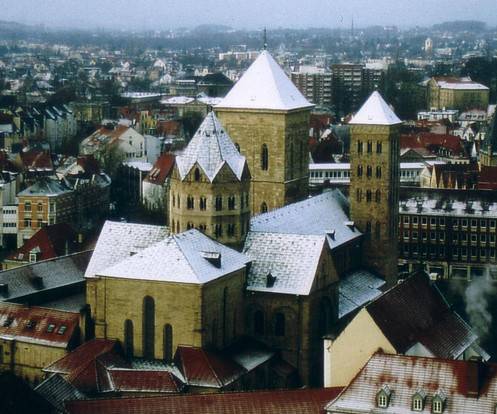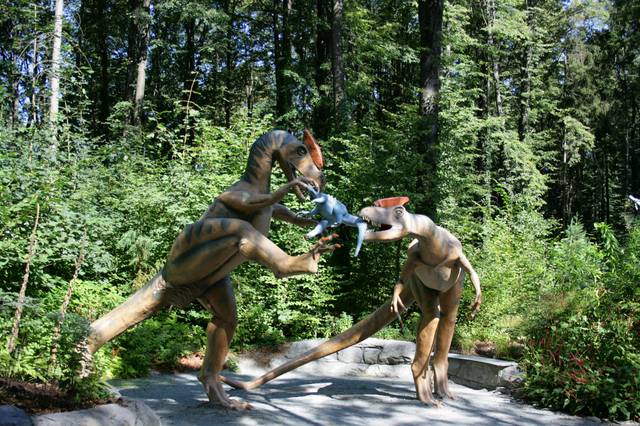
Bautzen is an old city in Saxony, Germany. It is a well preserved medieval city and the cultural center of the Sorbian community in Germany.

While an eastern Germanic settlement existed in the 3rd century AD and archaeology finds habitation back to the late Stone Age, the oldest written records date from 1002. One of the battlefields of the Napoleonic War Battle of Bautzen in 1813 and the World War 2 Battle of Bautzen, the town has at various times been part of Poland, Bohemia, Hungary, Saxony, Germany or East Germany. Bautzen was infamous throughout East Germany for its penitentiaries. During World War II, a subcamp of the Groß-Rosen concentration camp operated in Bautzen; in Cold War Europe, Bautzen I was an official prison while the secret Bautzen II imprisoned prisoners of conscience. Since 1993, Bautzen II has served as a memorial. Bautzen's medieval town centre is defended by a city wall on the steep embankment to the river Spree. St. Peter's Cathedral is Eastern Germany's only historic interdenominational church edifice; the Hexenhaus (Witch's House, built 1604) is the oldest preserved residential building. The Reichenturm is one of the steepest leaning towers north of the Alps to still be passable. The Old Waterworks (built 1558), an architectural monument and museum, is one of the oldest preserved waterworks in central Europe. Other sites of interest include Ortenburg Castle and four museums including the Stadtmuseum Bautzen ("Bautzen city Museum") and the Sorbisches Museum ("Sorbian Museum", Sorbian: Serbski muzej).

Above all Bautzen is renowned for its historical town centre with its skyline of medieval towers. Some examples:
- The Reichenturm: One of the steepest leaning and still passable towers north of the Alps
- Ortenburg Castle
- Hexenhaus, Vor der Fischerpforte. The Hexenhäusel is one of the oldest residential buildings in Bautzen. A former fisherman's house built before 1604, it survived the great 1634 fire which caused great damage to the city; it also survived subsequent fires and wars. According to popular lore, the house was said to have withstood all fires because it was protected by a gypsy's spell. A distinctive listed historic building widely depicted in postcards circa-1900 and reconstructed in 1959/60, it has old-style wooden roof shingles and wooden gutters.
- The Old Waterworks: architectural monument and museum; landmark of Bautzen
- Saint Peter's Cathedral: Germany's oldest and Eastern Germany's only historic interdenominational church edifice. The tower is passable, take the door at west side.
- Bautzen Memorial, Weigangstraße 8a, +49 3591-40474. 10AM-4PM Mo-Th, 10AM-8PM Fr, 10AM-6PM Sa-Su. The former Stasi prison, Bautzen II commemorates victims incarcerated in the Bautzen prisons under inhuman conditions during the Soviet occupation and SED dictatorship. See detention cells, the isolation tract, exercise yards and permanent exhibitions documenting victims' suffering and the political and historical context. Free public guided tours 5PM Fri, 11AM Sat/Sun, 2PM Sat/Sun. Individual guided tours €60 (in English €70) by appointment.
- Sorbisches Museum, Ortenburg 3 (in Ortenburg Castle, +49 3591-270870-0. 10AM-6PM daily, closed Mon. Sorbian trade and traditional costumes, music and religious faith, settlement history and contemporary art. €2.50.
- Go on a tour through town or rest at romantic places, go into the museums or go shopping
- The city nestled in the heart of Upper Lusatia offers plenty of opportunities for memeroable hikes and day trips. The bioshere preserve "Upper Lusation Pond and Heath Region" extends an area of 21.800 hectares with over 240 ponds. You can easily do day trips to the Upper Lusatian Highlands.
- Do water sports at the Bautzen reservoir

Bautzen is often called the "Easter-capital". Sorbian and German customs, including famous processions during Easter, meet with a great deal of interest. Easter events:
- Easter eggs market
- Easter riding in Bautzen and the villages around
- "Eierschieben"
- Wedding of the Birds"
- Bautzen has an important summer open air theater
- street festival "Bautzener Frühling"
- Easter eggs
- Bautz'ner Senf - one of East Germany's best known specialities. In fact if people hear Bautzen, they usually think one of two things: the notorious Stasi prison - or mustard.
Sorbian and traditional German-Lusatian cuisine.
- Mönchshof, Burglehn 1, +49 3591 490141. "Medieval" style restaurant with occasional live music. Website in German and English 10€ to 15€ for a main course.
Bautzen beer is only obtainable in only a few places in the city, but it's worth trying.
 Dmoz:Regional/Europe/Germany/States/Saxony/Localities/Bautzen/
Dmoz:Regional/Europe/Germany/States/Saxony/Localities/Bautzen/
